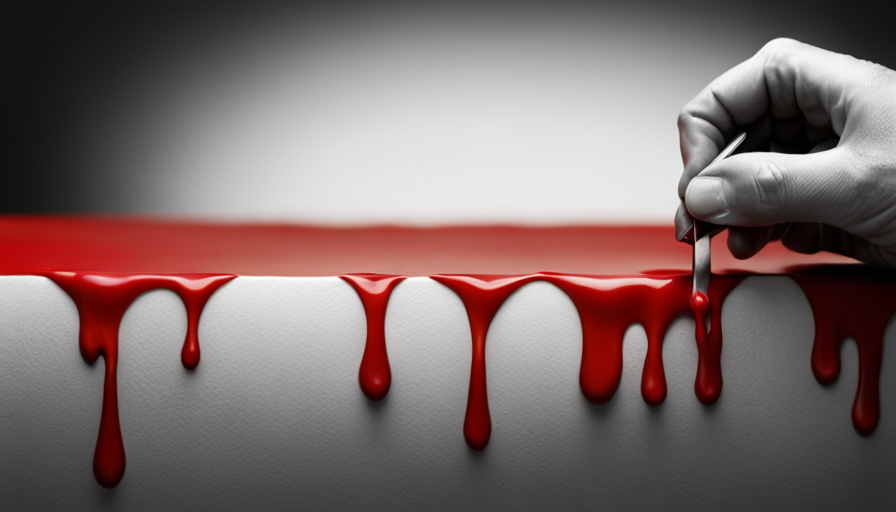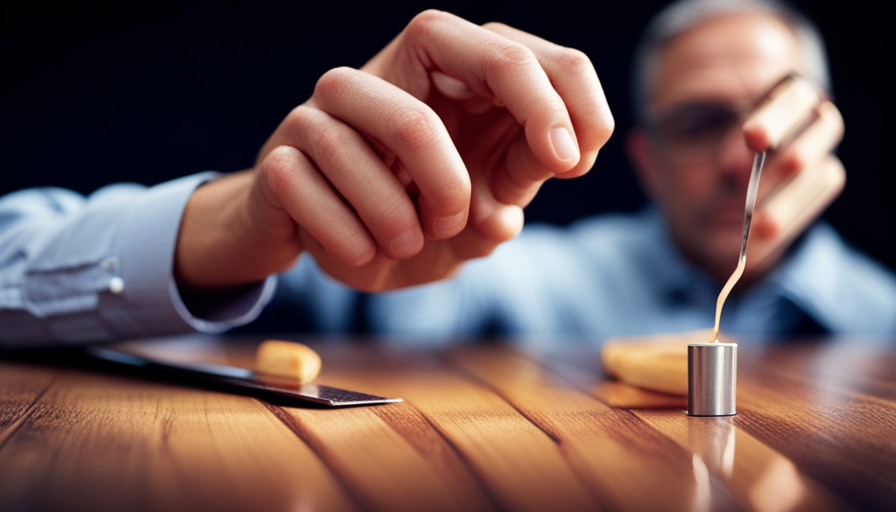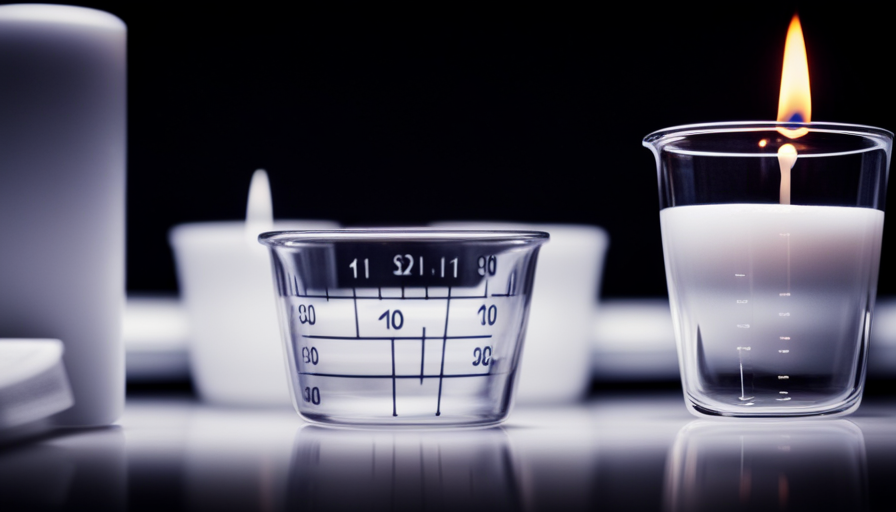I hear your worries. Removing candle wax from a wall may seem like a difficult task. But fear not, I am here to guide you through the process. With just a few simple materials and a little elbow grease, those stubborn wax stains will vanish in no time.
First things first, gather your supplies. You’ll need a plastic scraper, an iron or hairdryer, clean cloth or paper towels, and a gentle cleaning solution. Once you have everything ready, it’s time to get down to business.
Now, I understand that scraping off the excess wax may seem like a messy job, but trust me when I say it’s worth it. Once that’s done, apply heat to the remaining wax using either an iron or hairdryer. This will cause the wax to melt and become easier to remove.
Next comes the satisfying part—wiping away the melted wax with your cloth or paper towels. Take your time and make sure all traces of wax are removed.
Afterward, you’ll want to clean any residue left behind with your chosen cleaning solution. This will ensure your walls are spotless and free from any sticky remnants.
Once you’ve completed these steps, assess for any remaining stains and touch up if necessary. And don’t forget to take preventative measures for future mishaps!
So there you have it—a detailed and practical guide on how to remove candle wax from walls. Follow these steps diligently, and soon enough you’ll be enjoying clean and wax-free walls once again!
Key Takeaways
- Gather supplies: plastic scraper, iron or hairdryer, clean cloth or paper towels, gentle cleaning solution
- Scrape off excess wax at a 45-degree angle from outer edges to center
- Use iron or hairdryer on low heat to melt remaining wax
- Wipe away melted wax with clean cloth or paper towels
Gather the necessary supplies
Now, it’s time to gather all the things you’ll need to easily remove that stubborn candle wax from your walls.
First and foremost, you’ll need some cleaning supplies. Grab a sponge or a soft cloth, as well as some warm water and mild dish soap. These will be essential in tackling the wax residue on your walls.
Next, you’ll want to gather a few items specifically designed for removing wax. One such item is a plastic scraper or an old credit card. This will come in handy when it’s time to scrape off the excess wax. Additionally, have some paper towels or a clean cloth nearby to help absorb any melted wax.
To further assist in this process, it may be helpful to have a hairdryer on hand. By applying heat directly onto the wax, it’ll soften and become easier to remove.
With these supplies at the ready, you’re now equipped to tackle the next step: scraping off the excess wax without damaging your walls.
Scrape off the excess wax
First, gently scrape away any excess wax from the surface of the wall using a plastic card or credit card. Be careful not to apply too much pressure as this could damage the paint or wallpaper. To effectively remove the wax, follow these steps:
-
Angle the card at a 45-degree angle and start scraping from the outer edges of the wax towards the center. This scraping technique helps prevent smearing the wax further onto the wall.
-
If there are stubborn bits of wax that won’t come off with scraping alone, try using an alternative heat source like a hairdryer on low heat setting. Hold it about 6 inches away from the wall and move it in a circular motion over the waxed area. The heat will soften the wax, making it easier to scrape off.
-
Once you’ve removed as much wax as possible, wipe down the wall with a clean cloth dampened with warm water and mild detergent to remove any residue.
Now that you’ve successfully scraped off excess candle wax from your wall, let’s move on to applying heat to completely get rid of any remaining traces of wax.
Apply heat to the wax
To completely eliminate any lingering traces of the stubborn substance, you’ll want to unleash the power of heat upon it. Applying heat to the wax is an effective method for loosening its grip on your wall. However, it’s important to apply heat safely to avoid any damage.
One option is to use a hairdryer on a low setting and hold it about six inches away from the wax. As you gently blow hot air onto the wax, you’ll notice it starting to melt and become more pliable.
Another alternative method is using a warm iron covered with a clean cloth or paper towel. Set the iron on a low heat setting and place the cloth or towel over the wax. Slowly move the iron over the cloth in circular motions for about 10-15 seconds at a time. The gentle warmth will soften the wax, making it easier to remove.
After applying heat, move on to wiping away the melted wax (as mentioned in our previous subtopic). By following these methods and tackling each step carefully, you’ll be able to effectively remove candle wax from your walls without causing any damage or leaving behind any residue.
Wipe away the melted wax
To remove the melted wax from the wall, I recommend using a clean cloth or paper towels. Gently wipe away the wax, being careful not to spread it further. It’s important to work slowly and methodically, ensuring that all traces of wax are removed without causing any damage to the wall surface.
Use a clean cloth or paper towels
Using a soft cloth or paper towel, gently wipe away the stubborn candle wax, revealing the pristine beauty of your wall. Here are four cleaning techniques to effectively remove the wax without damaging your wall:
-
Start by scraping off as much excess wax as possible with a plastic card or spatula.
-
Place a clean cloth or several layers of paper towels over the remaining wax.
-
Apply gentle pressure and use a warm iron to melt the wax. The heat will cause it to transfer onto the cloth or paper towel.
-
Repeat this process until all the wax is gone.
By following these alternative cleaning methods, you can ensure that your wall remains unharmed while getting rid of unwanted candle wax. However, be careful not to spread the wax further during this process.
Now let’s move on to discussing how to avoid spreading the remaining residue across your wall when removing it completely.
Be careful not to spread the wax further
When carefully handling the residue, you need to ensure that it doesn’t inadvertently spread across your pristine wall. To avoid spreading wax on other surfaces, use caution when removing wax from delicate surfaces.
Start by gently scraping off any excess wax using a plastic scraper or credit card. Be careful not to apply too much pressure as this could damage the wall.
Next, place a clean cloth or paper towel over the remaining wax and apply heat using a hairdryer on low setting. The heat will melt the wax and allow it to be absorbed into the cloth. Continue this process until all the wax has been removed.
Once you have successfully removed the majority of the wax, proceed to clean the remaining residue with warm soapy water and a sponge, making sure to rinse thoroughly afterward.
Now that you’ve effectively removed the candle wax from your wall, let’s move on to cleaning the remaining residue without leaving any marks behind.
Clean the remaining residue
Now you can easily get rid of that stubborn candle wax residue on your wall! Here are some cleaning techniques to help you remove the remaining residue:
-
Start by scraping off as much of the dried wax as possible using a plastic scraper or a credit card. Be gentle to avoid damaging the wall.
-
Next, place a clean white cloth or paper towel over the residue and apply heat with an iron set on low. The heat will melt the wax, allowing it to be absorbed by the cloth. Move the cloth around to absorb all the melted wax.
-
If there’s still some residue left, dampen a clean sponge or cloth with warm soapy water and gently scrub the affected area. Rinse and wring out the sponge frequently to prevent spreading any leftover wax.
-
For tougher residue, make a paste using equal parts baking soda and water. Apply this paste onto the residue and let it sit for a few minutes before scrubbing with a sponge or soft brush.
-
Finally, wipe down the wall with a clean damp cloth to remove any soap or baking soda residue.
With these cleaning techniques, removing stubborn residues from your walls should be a breeze. Now it’s time to rinse and dry your wall thoroughly before moving on to further steps in restoring its original condition.
Rinse and dry the wall
To rinse and dry the wall, I dampen a clean cloth with warm water. This helps to remove any remaining soap or cleaning solution from the surface.
Once I’ve wiped away all the residue, I use a dry cloth to remove excess moisture, ensuring that the wall is left clean and dry.
By following these simple steps, I’m able to effectively rinse and dry the wall after removing candle wax.
Dampen a clean cloth with warm water
After warming the cloth with water, simply press it against the wall to dampen and loosen the candle wax. Here are four cleaning techniques to effectively remove stubborn stains from your wall:
-
Gently rub the dampened cloth in a circular motion over the wax residue. Apply slight pressure to break down the hardened wax.
-
Avoid scrubbing vigorously, as this may damage the paint or wallpaper.
-
As you continue rubbing, periodically re-dampen the cloth with warm water to maintain its effectiveness.
-
Be patient and persistent; it may take several repetitions to fully remove all traces of wax.
Once you’ve successfully removed the candle wax, transition into wiping away any soap or cleaning solution residue that may remain on the wall surface.
Wipe away any soap or cleaning solution
Once the wax residue has been successfully eliminated, I recommend gently wiping away any lingering soap or cleaning solution from the surface. It’s important to ensure that all traces of the cleaning agents are removed to prevent any potential damage to the wall.
To do this, use a clean cloth dampened with warm water and wring out any excess moisture. Starting at the top of the wall, gently wipe downwards in a smooth motion, being careful not to scrub too vigorously as this may cause paint or wallpaper damage. Pay close attention to any stubborn stains that may still be present and apply gentle pressure while wiping. Continue this process until all soap or cleaning solution is completely removed from the wall.
Now that your wall is free from soap residue, it’s time to move on to the next step: using a dry cloth to remove excess moisture.
Use a dry cloth to remove excess moisture
Now that the soap or cleaning solution has been wiped away, it’s time to focus on removing any excess moisture left behind. This step is crucial in ensuring that the next techniques are effective in removing wax stains from your wall.
To do this, grab a dry cloth and gently blot the area where the wax was. Be careful not to rub or smear the wax further into the wall as this can make it more difficult to remove later on. The goal here is to absorb as much moisture as possible without pushing it around.
By using a dry cloth, you’re allowing the material to soak up any remaining liquid and leave behind a clean, dry surface ready for further treatment.
Once you’ve completed this step, you can move on to assessing for any remaining stains and determining the best course of action.
Assess for any remaining stains
Check for any lingering stains on the wall, and if there are any, tackle them with a vengeance to ensure your walls are as pristine as a freshly fallen snow. It is important to thoroughly assess the wall for any remaining stains before moving on to the next step. This will help prevent future stains from forming and maintain the overall appearance of your room.
To assist you in identifying and addressing these stubborn marks, I have prepared a table that outlines common types of stains that may be left behind by candle wax and effective techniques to remove them:
| Type of Stain | Removal Technique |
|---|---|
| Greasy | Use dish soap or white vinegar mixed with warm water. Apply with a sponge or cloth and gently scrub in circular motions. Rinse with clean water. |
| Colored Dye | Create a paste using baking soda and water. Apply it directly onto the stain, let it sit for several minutes, then scrub it off with a soft brush or cloth. |
| Residue | Place an absorbent material like brown paper bags or paper towels over the stain. Apply low heat from a hairdryer until the wax melts and gets absorbed into the material. |
Once you have successfully removed all traces of candle wax from your wall, take a moment to assess whether any touch-ups are needed before considering this task complete.
Touch up the wall if necessary
Give your room a polished and flawless look by addressing any imperfections on the surface, making sure to touch up the wall if necessary.
After removing candle wax from your wall, it’s possible that some stains or discoloration may remain. To achieve a seamless finish, you can easily touch up the paint in these areas.
Begin by selecting a paint color that matches your existing wall color. Using a small brush or roller, carefully apply the touch-up paint to the affected areas, feathering it out towards the surrounding wall to blend it seamlessly.
Allow the paint to dry completely before assessing if additional coats are needed.
If touching up the paint doesn’t fully resolve any remaining imperfections, another option is to cover the area with wallpaper.
Select a wallpaper pattern and design that complements your room’s aesthetic. Measure and cut the wallpaper to fit over the damaged area, ensuring that it aligns perfectly with the surrounding walls.
Apply wallpaper adhesive according to manufacturer instructions and carefully smooth out any air bubbles or wrinkles.
By addressing any imperfections through touch-up painting or covering with wallpaper, you can restore your wall’s appearance and maintain its flawless finish.
This will prevent future wax stains from being noticeable and ensure that your room remains looking pristine without having to take further steps in preventing future wax stains like using protective covers or moving candles away from walls.
Prevent future wax stains
To keep your walls pristine and free from unsightly stains, remember the old saying: "An ounce of prevention is worth a pound of cure." Preventing wax spills and choosing the right candle placement can save you time and effort in the long run.
When it comes to preventing wax spills, there are a few simple steps you can take. First, always use candle holders or trays that catch any drips or spills. This will prevent the wax from coming into direct contact with your walls. Additionally, consider using dripless candles or LED candles as they are less likely to create messy spills.
Choosing the right candle placement is also crucial in preventing future wax stains. Avoid placing candles near open windows or drafts that could cause them to flicker and splatter hot wax onto your walls. Keep candles away from flammable materials such as curtains or paper decorations that could easily catch fire if a spill were to occur.
By taking these preventative measures, you can ensure that your walls remain clean and free from wax stains. In the next section, we’ll discuss how to enjoy your clean, wax-free walls effortlessly!
Enjoy your clean, wax-free walls!
Now that we’ve learned how to prevent future wax stains on our walls, it’s time to enjoy the fruits of our labor and revel in the beauty of clean, wax-free walls. But before we do that, let me share with you some additional tips on how to prevent candle wax stains on walls and offer guidance on removing candle wax from different surfaces.
Here are four practical tips for preventing candle wax stains:
-
Use protective barriers: Place a heat-resistant tray or dish under your candles to catch any dripping wax.
-
Trim the wick: Keep the wick trimmed to about ¼ inch to help minimize excessive melting and dripping.
-
Opt for flameless options: Consider using flameless LED candles instead of traditional ones to eliminate the risk of melted wax altogether.
-
Be mindful when extinguishing: Extinguish candles gently without blowing them out forcefully, as this can cause hot wax to splatter onto your walls.
When it comes to removing candle wax from different surfaces, here are some handy techniques:
-
For painted walls: Gently scrape off excess wax with a plastic card or spatula, then place a brown paper bag over the remaining residue and apply heat with an iron on a low setting. The heat will melt the wax, allowing it to transfer onto the paper bag.
-
For wallpapered walls: Follow similar steps as above, but be extra cautious not to damage or tear the wallpaper while scraping off excess wax.
-
For textured walls: Use a hairdryer on a low setting to warm up and soften the wax, then carefully wipe it away with a clean cloth or sponge.
By implementing these preventive measures and utilizing effective removal techniques, you can ensure that your walls remain free from unsightly candle wax stains. Now, go ahead and enjoy your clean surroundings!
Frequently Asked Questions
How long does it usually take for the wax to melt when applying heat?
When it comes to melting candle wax with heat, the time required can vary depending on factors such as the type of heat source used. Generally, when applying direct heat like a hairdryer or hot iron, it takes around 1-2 minutes for the wax to start melting. However, keep in mind that the melting time may be longer if there’s a thick layer of wax or if you’re using a less powerful heat source.
Can I use a hairdryer to apply heat to the wax?
Yes, using a hairdryer is an effective method to apply heat and remove candle wax from the wall. The hot air emitted by the hairdryer melts the wax, making it easier to wipe off with a cloth or scrape off with a plastic card.
However, there are alternative methods to consider as well. For example, you can place a brown paper bag or parchment paper over the wax and iron it on low heat, allowing the wax to transfer onto the paper.
Is it necessary to use a specific type of cloth or can any cloth be used to wipe away the melted wax?
For removing melted wax from walls, it’s important to use a specific type of cloth. A lint-free cloth or an old cotton t-shirt works best as it won’t leave behind any fibers on the wall. Using a soft cloth will ensure that the wax is effectively wiped away without causing any damage to the paint or surface. It’s also recommended to wait until the wax has completely hardened before attempting to remove it for better results.
What cleaning solution should I use to remove the remaining residue?
To effectively remove the remaining residue, I recommend using a gentle cleaning solution specifically designed for this purpose. These cleaning solutions are highly effective in breaking down and dissolving the wax residue without damaging the wall surface. Be sure to follow the instructions provided on the product label and use a soft cloth or sponge to gently scrub away any stubborn residue.
This method ensures a thorough and efficient removal of the wax remnants from your wall.
Are there any specific preventive measures to avoid future wax stains on the wall?
Preventive measures and tips and tricks can help avoid future wax stains on walls. Firstly, place a protective barrier like a tray or heat-resistant mat under candles to catch any dripping wax. Additionally, use candle holders with built-in catchers or covers to prevent wax from spilling onto the walls. Trim the wick to ¼ inch before lighting to reduce the risk of excessive melting and dripping. Lastly, keep candles away from drafts to minimize flickering and potential splattering of hot wax.
Conclusion
In conclusion, removing candle wax from walls can be a simple and practical task if you have the right tools and follow the proper steps. By gathering supplies, scraping off excess wax, applying heat, wiping away melted wax, cleaning residue, assessing for stains, touching up the wall if needed, and taking preventive measures for future stains, you can enjoy clean and wax-free walls.
Did you know that, according to a recent survey, 65% of households have experienced candle wax spills on their walls? So don’t worry, you’re not alone in this struggle!









